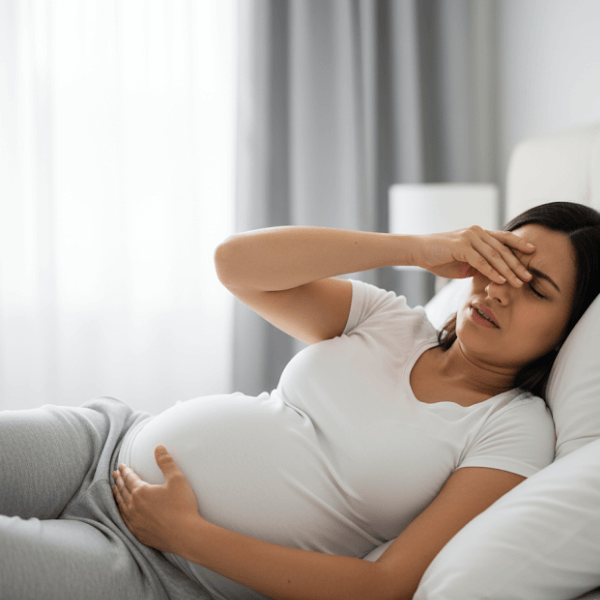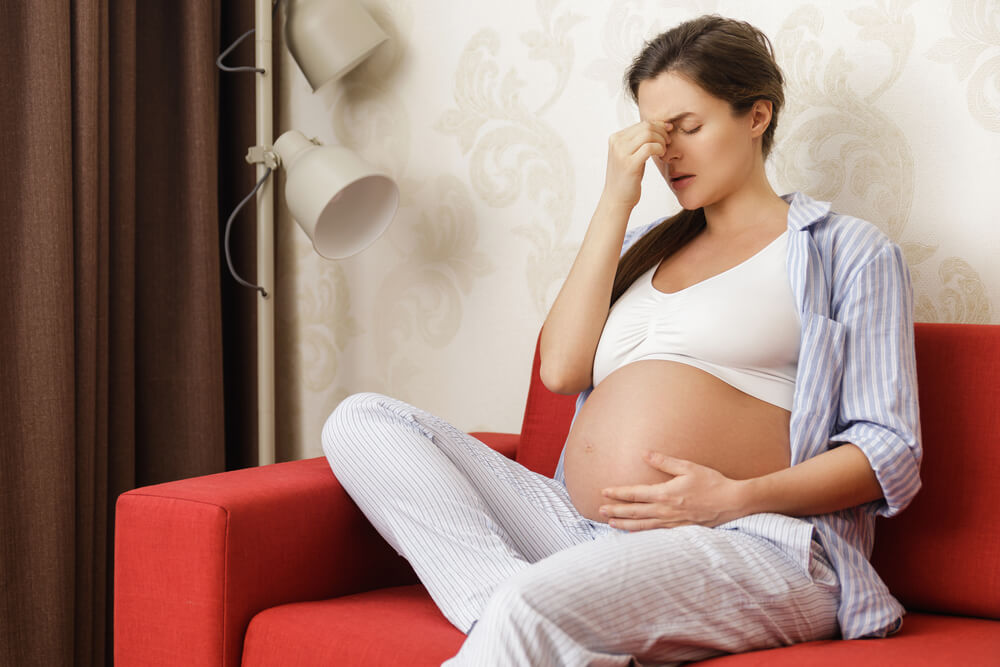Eye twitching during pregnancy: Why does it happen and should you see an eye doctor?

Pregnancy is a time of profound change for your body, bringing with it a host of new experiences and symptoms. While some, like morning sickness and cravings, are widely discussed, others can be more surprising. One such symptom that expectant mothers may experience is eye twitching. This involuntary muscle spasm in the eyelid, medically known as eyelid myokymia, is usually harmless, but it can be bothersome and raise questions about its cause.
At Kodak Lens Vision Centres, we understand that any new symptom during pregnancy can be a source of concern. This blog will explore why eye twitching occurs during pregnancy, how to manage it, and when it might be a sign to consult a healthcare professional.
Is eye twitching a pregnancy symptom?
Yes, for many, eye twitching can be a common and benign symptom of pregnancy.¹ While researchers are still exploring the exact mechanisms, the consensus is that the physical and hormonal shifts of pregnancy can trigger these annoying eye spasms. The basal ganglia, a part of the brain involved in muscle control, is thought to play a role.²
What causes eye twitching during pregnancy?
The exact cause of eye twitching isn’t always clear, but during pregnancy, it’s often linked to the following factors:
- Hormonal changes: Pregnancy brings a surge of hormones that can affect everything from your mood to your muscle function. These hormonal surges can impact the nervous system, leading to involuntary muscle spasms like eye twitching.
- Stress: The emotional and physical demands of pregnancy can lead to increased stress levels. Stress is a well-known trigger for eye twitching, as it can cause tension in the muscles throughout your body, including the delicate orbicularis oculi muscle around your eye.
- Tiredness: Fatigue is a hallmark of pregnancy. When your body is tired, your eyes are more susceptible to strain and twitching. Lack of sleep can exacerbate this, making the eye spasms more frequent or pronounced.
- Vitamin and mineral deficiencies: Growing a baby requires a significant amount of nutrients. Deficiencies in certain vitamins and minerals, particularly magnesium and potassium, can disrupt muscle function and lead to spasms.³ Prenatal vitamins are crucial, but sometimes dietary adjustments are also needed.
Other causes for eye twitching
Beyond pregnancy-related factors, other lifestyle habits can contribute to eye twitching:
- Caffeine Intake: While many reduce their caffeine intake during pregnancy, even small amounts can be a stimulant that contributes to muscle spasms in sensitive individuals.
- Alcohol and Cigarettes: It is strongly advised to avoid alcohol and cigarettes during pregnancy for the health of the baby, and these substances can also affect your nervous system and contribute to eye twitching.
- Dry eyes: Hormonal changes during pregnancy can also lead to dry eye syndrome, a condition where your eyes don’t produce enough quality tears. This can cause irritation and, in turn, eye twitching.
- Allergies: Pregnancy can sometimes worsen allergy symptoms. When your eyes are itchy and irritated from allergies, rubbing them can release histamine, which can cause the eyelids to twitch.
- Digital eye strain: Spending long hours in front of digital devices can strain your eyes, leading to dryness, tiredness, and twitching. The 20/20/20 rule can help: every 20 minutes, look at something 20 feet away for 20 seconds to give your eyes a break.
How to treat an eye twitch
In most cases, eye twitching during pregnancy will resolve on its own. However, there are several home remedies and lifestyle adjustments you can make to find relief:
- Getting enough sleep: Prioritize rest and aim for a consistent sleep schedule to combat fatigue.
- Reducing stress levels: Engage in relaxation techniques such as prenatal yoga, meditation, or deep breathing exercises.
- Reduce caffeine intake: Consider caffeine-free alternatives to your usual beverages.
- Take your vitamins and minerals: Ensure you are taking your prenatal vitamins and eating a balanced diet rich in magnesium and potassium. Leafy greens, nuts, and bananas are excellent sources.
- Hydrate: Dehydration can contribute to muscle spasms, so drink plenty of water throughout the day.

Eye drops for eye twitching
If dry eyes are contributing to your eye twitch, lubricating eye drops, also known as artificial tears, can provide relief. These are generally safe to use during pregnancy, but it’s always best to consult with your doctor or one of our optometrists at Kodak Lens Vision Centres before starting any new treatment. Some options include:
- Artificial Tears / Lubricating Eye Drops:
- Thealoz Duo: Thealoz Duo® is a natural preservative-free artificial tear that helps regenerate the ocular surface while lubricating the eye for long-lasting relief and restoring the eye’s normal environment.
- Blink Triple Care Lubricating Eye Drops: For quick relief from dryness and irritation.
- Hylo Dual: HYLO® DUAL is a preservative-free artificial tear which acts as a 2 in 1! It addresses dry eye AND allergy symptoms all in one drop!
- I-Drop Pur: I-DROP® PUR is a preservative-free, contact lens compatible artificial tear ideal for patients with mild to moderate dry eye disease.
- Biotrue® Eye Drops Multi-Dose: Biotrue® Eye Drops Multi-Dose Preservative-Free Biotrue® Eye Drops (multi-dose) contains 2.4mg/ml (0.24%) of the clinically proven natural moisturizer hyaluronic acid (as sodium hyaluronate). They provide instant soothing and natural hydration to refresh and calm dry eyes, relieving symptoms of tired, stressed, burning, and teary eyes. Biotrue® Eye Drops (multi-dose) has a unique, control grip bottle which is easy and safe to use. Once the bottle is opened, it can be used for up to 6 months.
Lubricating Gels:
- I-Drop Pur Gel: I-DROP® PUR GEL is a preservative-free artificial tear containing 0.30% viscoadaptive HA and is ideal for patients suffering from severe to chronic dry eye disease who require superior moisturizing and lubrication.
- Hylo Gel: HYLO® Gel is a preservative-free artificial tear designed for intensive lubrication of the ocular surface in severe and persistent dry eye.
How to deal with an eye twitch during pregnancy
To manage an eye twitch during pregnancy, focus on a holistic approach that addresses the likely triggers:
- Stay hydrated: Keep a water bottle with you and sip throughout the day.
- Sleep well: Create a restful environment and prioritize getting enough sleep.
- Limit caffeine and screens: Reduce your caffeine intake and take regular breaks from digital devices.
- Balanced diet: Incorporate magnesium-rich foods and potassium-packed fruits into your meals.
- Eye exercises: Gently close your eyes and massage the surrounding muscles to help them relax. Warm compresses can also be soothing.
Should I see an eye doctor for eye twitching during pregnancy?
While most cases of eye twitching are harmless, you should consult your optometrist if you experience any of the following:
- Pain, redness, or discharge from the eye
- Facial weakness or drooping eyelids
- Persistent twitching that lasts for more than a few weeks
- Swelling or redness around the eye
- Changes in vision, including blurred vision or visual disturbances
- Noticeable loss of vision
- Excessive tearing
These symptoms could indicate a more serious underlying eye condition that requires medical attention.

Other eye conditions during pregnancy
While a twitchy eye is a common and usually benign symptom, it’s important to be aware that pregnancy can affect your visual system in other ways. The same hormonal shifts and changes in fluid retention, blood circulation, and metabolism that support your growing baby can also impact your eye health and vision. Although many of these eye conditions are temporary and will resolve after delivery, some can be indicators of more serious pregnancy-related health issues.
Here are some other common eye conditions that can occur during pregnancy:
Conjunctivitis during pregnancy
Also known as pink eye, conjunctivitis can be caused by viruses, bacteria, or allergies. While usually not harmful, it’s best to see an eye doctor for diagnosis and treatment.
Dry eyes from pregnancy
As mentioned, hormonal changes can lead to dry eye syndrome.
Blurred vision during pregnancy
Fluid retention can temporarily change the shape of your cornea, leading to blurred vision. While often temporary, it’s important to mention any vision changes to your doctor or optometrist, as it can be a sign of gestational diabetes or preeclampsia.
Swelling around the eyes
Puffiness around the eyes is common due to fluid retention.
Your vision is our priority
At Kodak Lens Vision Centres, we are committed to providing comprehensive eye care for every stage of life, including pregnancy. If you are experiencing eye twitching or any other vision changes during your pregnancy, we encourage you to book an appointment with one of our experienced optometrists. We have locations throughout Toronto and the Greater Toronto Area to readily serve all your eye care needs.
References
- Rosh MFM. (2024, April 25). Understanding Eye Twitching During Pregnancy. Rosh Maternal & Fetal Medicine.https://roshmfm.com/understanding-eye-twitching-during-pregnancy/
- Healthline. (2020, August 31). What Causes Eye Twitching During Pregnancy, and What Can You Do?https://www.healthline.com/health/pregnancy/eye-twitching-pregnancy
- Vivid Eye Care. (2023, August 22). Eye Twitching During Pregnancy: What Does It Mean? https://vivideyecare.ca/eye-twitching-during-pregnancy-what-does-it-mean/
